

OUTCROP
Newsletter of the Rocky Mountain Association of Geologists





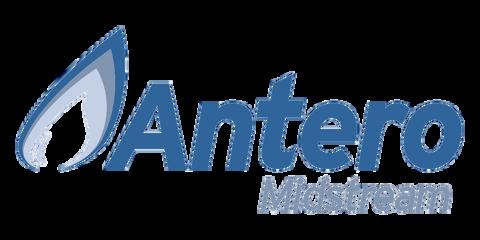




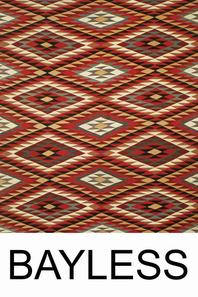
OUTCROP
Newsletter
of the Rocky Mountain Association of Geologists
730 17th Street, B1, Denver, CO 80202 • 720-672-9898
The Rocky Mountain Association of Geologists (RMAG) is a nonprofit organization whose purposes are to promote interest in geology and allied sciences and their practical application, to foster scientific research and to encourage fellowship and cooperation among its members. The Outcrop is a monthly publication of the RMAG.
2025 OFFICERS
PRESIDENT
AND BOARD OF DIRECTORS RMAG STAFF
Matthew Bauer matthew.w.bauer.pg@gmail.com
PRESIDENT-ELECT Sandra Labrum slabrum@slb.com
1st VICE PRESIDENT
Nate La Fontaine nlafontaine@sm-energy.com
1st VICE PRESIDENT-ELECT Rachael Czechowskyj sea2stars@gmail.com
2nd VICE PRESIDENT Ali Sloan ali@sloanmail.com
2nd VICE PRESIDENT-ELECT Lisa Wolff lwolff@bayless-cos.com
SECRETARY Drew Scherer latirongeo@gmail.com
TREASURER
Astrid Makowitz astridmakowitz@gmail.com
TREASURER-ELECT
Walter Nelson wnelson@integratedenergyresources.com
COUNSELOR
John Benton jbenton@haitechinc.com
ADVERTISING INFORMATION
Rates and sizes can be found on page 42. Advertising rates apply to either black and white or color ads. Submit color ads in RGB color to be compatible with web format. Borders are recommended for advertisements that comprise less than one half page. Digital files must be PC compatible submitted in png, jpg, tif, pdf or eps formats at a minimum of 300 dpi. If you have any questions, please call the RMAG office at 720-672-9898.
Ad copy, signed contract and payment must be received before advertising insertion. Contact the RMAG office for details.
DEADLINES: Ad submissions are the 1st of every month for the following month’s publication.
The Outcrop is a monthly publication of the Rocky Mountain Association of Geologists
DESIGN/LAYOUT: Nate Silva | n8silva.com
EXECUTIVE DIRECTOR
Bridget Crowther bcrowther@rmag.org
LEAD EDITOR
Danielle Robinson danielle.robinson@dvn.com
CONTRIBUTING EDITORS
Elijah Adeniyi eadeniyi@slb.com
Nate LaFontaine nlafontaine@sm-energy.com
RMAG CODE OF CONDUCT
RMAG promotes, provides, and expects professional behavior in every engagement that members and non-members have with the organization and each other. This includes respectful and inclusive interactions free of harassment, intimidation, and discrimination during both online and in-person events, as well as any content delivered by invited speakers and instructors. Oral, written or electronic communications that contain offensive comments or demeaning images related to race, color, religion, sex, national origin, age, disability, or appearance are not appropriate in any venue or media. RMAG reminds members of the diversity and mission statements found on our website. Please direct any questions to staff@rmag.org




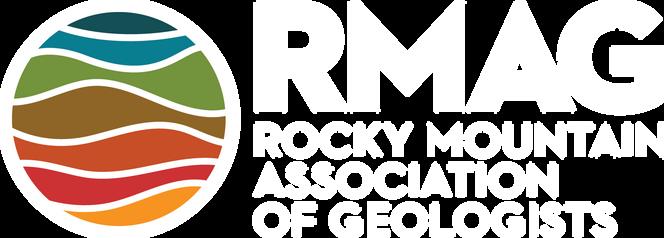
MEMBERS
EVENT ATTENDEES
WEBSITE VISITORS
OUTCROP READERS
COMMUNITY CONTACTS
EMAIL SUBSCRIBERS
NETWORKING EVENTS
CONTINUING EDUCATION EVENTS
FIELD TRIPS
IN 2025YOUR SUMMIT SPONSORSHIP DOLLARS SUPPORTED: 1,200 1,400 8,000 8,000 7,000 4,000 28 13 8
2 0 2 6



October 24, 2025
Geoscience Community:
We greatly appreciate every Summit Sponsor and Event Sponsor who contributed to RMAG over the last year. Your support is essential to our organization.
In 2025, the Rocky Mountain Association of Geologists was proud to host a dynamic lineup of events, including the North American Helium & Hydrogen conference, which examined the quickly growing field Members explored the beauty and geological wonders of the Grand Canyon and the San Jaun’s as well geology across the state. Volunteers shared their passion for geoscience with students across the region through classroom visits and community festivals. Members also enjoyed numerous opportunities to connect outside the office through monthly lunches, coffees, happy hours, and our annual Golf Tournament.
Looking ahead, 2026 brings new opportunities for RMAG and our partners. Your financial support allows us to start the year off with a luncheon on the State of the Industry before diving into the impacts of new and evolving technologies on industry including in AI’s ever-growing presence. Plans are coming together to host a fundamentals class series throughout the year, two separate symposiums on the research out of USGS and research on the Mowry. Networking in 2026 will include our regular happy hours and coffee hour networking, plus we’ll have Rockbusters, the Golf Tournament and we’re bringing back the Clay Shoot. With your support RMAG Members share the wonders of earth sciences through community and school outreach. Finally, your financial support is crucial to our publication efforts, which include the monthly Outcrop newsletter and the quarterly Mountain Geologist journal.
Your financial commitment includes enrollment opportunities across all the RMAG events, whether joining the educational opportunities and joining the comradery of the golf tournament your employees will gain access. RMAG also recognizes Summit Sponsors through in-person signage, on our website, in our publications, and on social media.
Thank you to our current Summit Sponsors; we look forward to your continued support in 2026. For those not yet sponsoring, now is the perfect time to get involved. Sponsorship with RMAG d irectly supports the geoscience community – fueling education, networking, and professional development opportunities throughout the Rocky Mountain region.
We invite you to review or sponsorship packages and find the level that best aligns with your company’s goals. Whether you choose to become an annual Summit Sponsor or support a single event, your partnership will help us advance geoscience education and keep our community thriving.
Become a Summit Sponsor by contacting RMAG Executive Director, Bridget Crowther at bcrowther@rmag.org or 720-672-9898 to discuss opportunities and reserve your sponsorship for 2026.
Sincerely,
Sandra Labrum
Bridget Crowther 2026 RMAG President RMAG Executive Director


12
Registration

RMAG 2026 SUMMIT SPONSORSHIP
All sponsor benefits event tickets follow RMAG event registration deadlines. All benefits end 12 months after registration.
Summit Sponsorship benefit term is for 12 months! Specify type of payment on signed form, and send logo and advertisements to staff@rmag.org
Company:
Company Representative:
Address:
City: State: Zip Code:
Phone: Email:
Name as it appears on Credit Card:
Credit Card #:
Expiration Date: Security Code:
Signature:
ACH: contact the RMAG office at staff@rmag.or for directions.
Mail Checks payable to RMAG:
Rocky Mountain Association of Geologists (RMAG)
730 17th Street, B1 Denver, CO 80202
RMAG events are subject to change. Cancellation or rescheduling of events does not give the sponsor the right to refund. Summit Sponsors will receive benefits at any new events added into the RMAG schedule.
Thank you for your generous support!
P: (720)672-9898 staff@rmag.org www.rmag.org

730 17th Street, B1 Denver, CO 80202
RMAG OCTOBER 2025 BOARD OF DIRECTORS MEETING
By Drew Scherer, Secretary flatirongeo@gmail.com
Happy Fall RMAG, hope you are all enjoying the cool weather and perhaps going out in the mountains for some fun snow sport activities. The Board of Directors met on October 15th, 2025, at 4pm via Zoom. 4 board members were not present, but a quorum was met with 6 members in attendance. September was a good month for us with 7 events and strong attendance, despite having to move some of them around due to weather-related issues. Both The Outcrop and The Mountain Geologist saw a healthy level of viewership. As we roll into 2026 membership, you should be made aware that our membership voted in a nominal increase to the membership dues. Current membership dues are now $55 for Active Members, $47 for Associate Members, and $20 for Student Members.
The Finance Committee began the meeting with an overview of the financial position of the organization, which posted a net revenue gain of about $21k given the
strong performance of our stock portfolio. On the agenda, the Board voted during the meeting to rebalance our investment strategy to a slightly more conservative asset mix, along with having fiduciaries from Fidelity professionally manage our portfolio according to the market.
The Continuing Education committee reported good attendance at the October luncheon with 32 total attendees, of which 17 attended in-person. The CEC committee is working on 2026 events including a USGS Symposium next Spring, for our furloughed federal employee members who missed presenting at the RMS-AAPG section meeting due to the Government shutdown, another Rocky Mountain Rendezvous Career fair using lessons learned from this past month’s event, a Basin Conference, and Python Short courses. The Membership committee saw positive attendance rates at our Coffee and Happy Hour events and is working on planning this year’s Rockbusters Ball and a Clay Shoot fundraiser in the Spring-early Summer.

The Publications Committee has a solid pipeline of leads and confirmed articles for upcoming issues of The Outcrop and The Mountain Geologist, with the next issue for the latter coming out in December with at least 4 articles. The Geoscience Outreach is wrapping up our year of outreach with a couple events including the Jeffco Career Fair, Storage Unit Maintenance, and Parker Science Night. Stay tuned for more information on volunteer opportunities early next year.
Lastly, due to the government shutdown and other factors both the Pueblo and Picketwire field trips have been cancelled, and the DMNS Planetarium Trip has been pushed back to later this winter, exact timing TBD. That being said, the OTR committee is never short on ideas and already has a robust set of field trips outlined for the 2026 field season.
Hope you have a great month, stay warm, have fun, and we will see you in the next issue of The Outcrop!


J o i n y o u r f e l l o w g e o s c i e n t i s t f o r a d r i n k

PRESIDENT’S LETTER
By Matthew Bauer
Dear Fellow Members,
Being Thankful
As the golden colors of autumn settle on the Front Range and the dusting of winter’s snow hits the high peaks, the ski season is coming. November invites us to pause amid our core, cuttings, seismic, and well logs. This month, let’s turn the loupe toward thankfulness. It is an emotion as fundamental to our craft as the stratigraphy we study.
I am thankful, first, for the rock record itself and the stories it can share. The awe of a Pennsylvanian world was beyond what I could see as a child. I filled my pencil box full of crinoid stems from the playground gravel. I am grateful for the world-class outcrops along the Front Range, teaching us patiently about a world gone by—oceans and dinosaurs. Mudstones cradle the stories of ancient seas. Sandstones tell of vanished rivers and sand bars. These silent witnesses have outlasted empires and ice ages. Yet, they graciously reveal their histories to those willing to look with a hammer, a hand lens, and humility.
I am thankful for you—our local geoscience community. For the mentors who traced anticlines on a
napkin at the Wynkoop Brewing Company after a SEPM talk. For the students whose questions at our RMAG luncheons at DERL cut through decades of dogma like fresh glacial melt. For the volunteers at the Mines Mineral Museum for hiding the miniatures of Blaster and his friends in the exhibits, giving children a gamified visit while they discover mineralogy. For the “retired” geologists who still show up at 7 a.m. field trips, thermos in hand, ready to share knowledge and experience.
I am thankful for the privilege of our work. While others see mountains, we see time—millions of years of changing environments. This perspective is a gift: to hold the deep past in our hands and use it to illuminate the future.
As you gather with family or chosen kin this Thanksgiving, may you carry this gratitude like a wellworn Brunton. Let it orient you. Let it remind you that every thin section, every porosity log, every debate over sequence boundaries is part of a larger story— one we are fortunate to help write.
Stay curious and be good to people,
—Matthew
W. Bauer

John C. Webb Consulting Geologist
Stratigraphy, Sedimentology and Petrography of Clastic and Carbonate Systems
Louisville, Colorado
Reservoir Characterization
Petroleum, SWD, CCUS, Geothermal
Johnwebb20@comcast.net
303.917.0644
WRITE FOR THE OUTCROP
The Outcrop is the monthly online newsletter of the Rocky Mountain Association of Geologists. The Outcrop circulates to the 1900-plus members of the RMAG and about 200 university libraries and industry associates. It's a great opportunity for young professionals to get their name out to other geologists in the community. It provides articles for the benefit and edification of its readers and gives authors a chance to reach local geologists on subjects that interest or concern them. Learn more here.










THE GREAT SALT LAKE METEORITE FALL OF 2022
BY JAMES KARNER, University of Utah

The author, hunting for meteorites, on the western edge of the Great Salt Lake.
Photo by Jani Radebaugh.
“H
EY KRIS. KRIS!”
I called, as I peered down my driveway in the Millcreek area of Salt Lake City. It was about 8:30 on the sunny Saturday morning of August 13, 2022, and my wife had asked me, as I was half-asleep in bed, to hold back one of our dogs as she attempted to whisk our other dog out the door for a walk. If you are a two-dog owner, you most likely understand this problematic situation. But that was a few minutes ago and she was gone, with both dogs. I turned to go back into the house when all of a sudden there was a spectacular BOOM! It was a very loud sonic boom, shattering the quiet morning, and it was immediately followed by the rumble of lesser booms, like rolling thunder! Now, full disclosure, I am the Principal Investigator for the US Antarctic Search for Meteorites (ANSMET) project and a research professor in the Geology department at the University of Utah- as such, I do probably think about meteorites daily. I had an immediate thought though about the noise I had just heard, but not because I hunt meteorites for a living. In an amazing coincidence the night just before, I had been perusing the handbook “From Weston to Creston: A Compendium of Witnessed Meteorite Falls 1807 to 2016” (Cressey, 2016). Hundreds of accounts are contained within it detailing brilliant bright fireballs lighting up the skies and the cacophonous explosions that accompany them, and then also the discovery of the meteorites that caused them. That sonic boom I had just heard, and that rolling, rumbling thunder lasting a few seconds...I stopped mid-stride, turned back toward where the sound came from and wondered, is that what a meteorite fall sounds like?!
ping of a text message from my buddy, “Are you out looking for the meteor? ”
“Wait, is that what that boom was?” I immediately texted back.
“Yeah, it’s on KSL...”
“I stopped mid-stride, turned back toward where the sound came from and wondered, is that what a meteorite fall sounds like?!”
That afternoon I awoke from a nap to the
KSL is a local news feed, so I immediately started searching on my phone. Sure enough, there were lots of messages about the sonic boom on the Nextdoor app and a copy of a Tweet sent out by Utah Governor Spencer Cox; it said the sound was not caused by seismic activity or any of the military installations in Utah, and was most likely caused by a meteor (i.e., an extraterrestrial mass that produces light as it travels through Earth’s atmosphere). Most meteors are small (dust to sand grain-sized) and are easily visible in the night sky as they light upand burn up- in the atmosphere. These are affectionately known as “shooting stars,” and the streak of light they generate lasts at most a second or two. The meteor that generated the kind of detonations I heard that morning had to be much larger, which meant it was probably visible as a fireball. A fireball is a very bright meteor, and the extraterrestrial masses (i.e., rocks) that cause fireballs are much larger than sand-sized grains. Like all meteors, they enter Earth’s atmosphere at incredible (i.e., cosmic) velocities, on average about 12 to 40 km/sec, or 27,000 to 90,000 mph! Their velocity is immediately and ferociously slowed down by the drag of our atmosphere, causing the outermost layers (of the rock) to melt and ablate away. Eventually, the rock gets so hot it begins to glow- it becomes incandescent. The atmosphere surrounding the rock gets hot enough to ionize the gasses it contains, and the air itself also becomes incandescent. The rock tearing through the atmosphere is now a fireball- a mass of hot glowing gas that

FIGURE 1: Screen capture from the 8/13/22 fireball reporting page (AMS, 2022) showing the location of eyewitnesses to the fireball: Figure icons with a green base saw the phenomenon travelling from right to left, while icons with a red base saw the phenomenon travelling from left to right in the sky. Pink and light blue dots on icons (e.g., in the Salt Lake City area) indicate the witness heard a sound accompanying the visual phenomenon (concurrent or after). The blue arrow is the inferred trajectory of the fireball.
can measure hundreds of feet across and can be visible for dozens of seconds or even minutes as it streaks across the sky (see Norton, 1998).
I quickly got on my computer and went to the American Meteor Society (AMS) webpage. The AMS has an easy-to-use reporting page and indeed a fireball had been reported that morning by about two dozen observers from Colorado, Utah, Idaho and Wyoming (Figure 1). The fireball was observed travelling east to west across the western states at about the latitude of Interstate 80. Several eyewitnesses to the fireball also heard detonations, but these were limited to a corridor of about 65 miles along Interstate 15 (N-S) from Lehi to Ogden, UT. I was smack in the middle of that range in southeastern Salt Lake City when I heard the sonic boom and rolling thunder. I guesstimated up to a million people may have heard the explosions! Next, I wondered if anyone had captured the fireball by video. They had! A
webcam at the Snowbasin ski resort, about 40 miles north of Salt Lake City, recorded the fireball at 8:30 AM local time. The webcam was pointing due south and caught the fireball streaking through the sky from east to west in a downward trajectory angle of about 30 degrees (Figure 2). In the video, the fireball can be seen for about two seconds before it visibly brightens and then goes dark and/or disappears behind the clouds. Wow, now I was excited! There was evidence that a fireball exploded (i.e., the sonic boom and rumbling thunder indicated fragmentation) somewhere west of Salt Lake City- did any pieces make it to the ground to become meteorites, and where did they land?!
To answer that question I turned to Dr. Marc Fries, a planetary scientist at the NASA Johnson Space Center. I’d known Marc since we were teammates on the 2009-10 ANSMET field team that recovered an impressive 1021 meteorites that season.

FIGURE 2: Photo still of the 8/13/22 fireball from a Snowbasin ski resort video camera. The view is almost due south and thus the fireball is travelling east to west over the Salt Lake City area that is about 40 miles to the south. (Image captured from www. snowbasin.com)
Marc had a preternatural ability to find meteorites; it’s like he could sniff them out, and then he would drive his snowmobile (or walk) right to them on the ice! But I wasn’t contacting Marc because he was a first-rate meteorite hunter, I was contacting him because he could tell me with little doubt if meteorites had fallen and where they landed. You see, around 2010, Marc and his brother Jeffrey (a meteorologist in the military) surmised that falling meteorites could be “seen” by Doppler weather radar. Weather radar works as an antenna sends radio waves out into the atmosphere- as the waves strike objects, energy is reflected back to the radar. The larger the object, the greater the intensity of the returns, while the Doppler effect detects motion toward or away from the radar, as well as the location of an object. Weather radar is obviously focused on precipitation, storms, i.e., weather, but it was also known to detect insect swarms, birds, volcanic ash clouds, etc. Marc
and Jeffrey showed that weather radar could also be used to identify meteorite falls- extraterrestrial rocks falling to Earth (Fries and Fries, 2010) at an altitude of ~20 km down to 1 km. At these altitudes, most meteor(ites) are in their final descent toward Earth; they’ve been slowed to the point where all of their cosmic velocity is spent, they are no longer optically visible, they are no longer burning and melting, and they are in a free-fall until they hit the ground. This is the “dark flight” phase of a meteor(ite), and the ability to track meteor(ite)s in this phase has dramatically increased the chances of meteorite recovery after fireball events. Prior to weather radar detection, meteorite landing locations were estimated from eyewitness reports or security camera video of the fireball path. And then, hopefully someone on the ground had seen or heard meteorites land, or there was damage to property and/or infrastructure- this type of info would help narrow the search on the
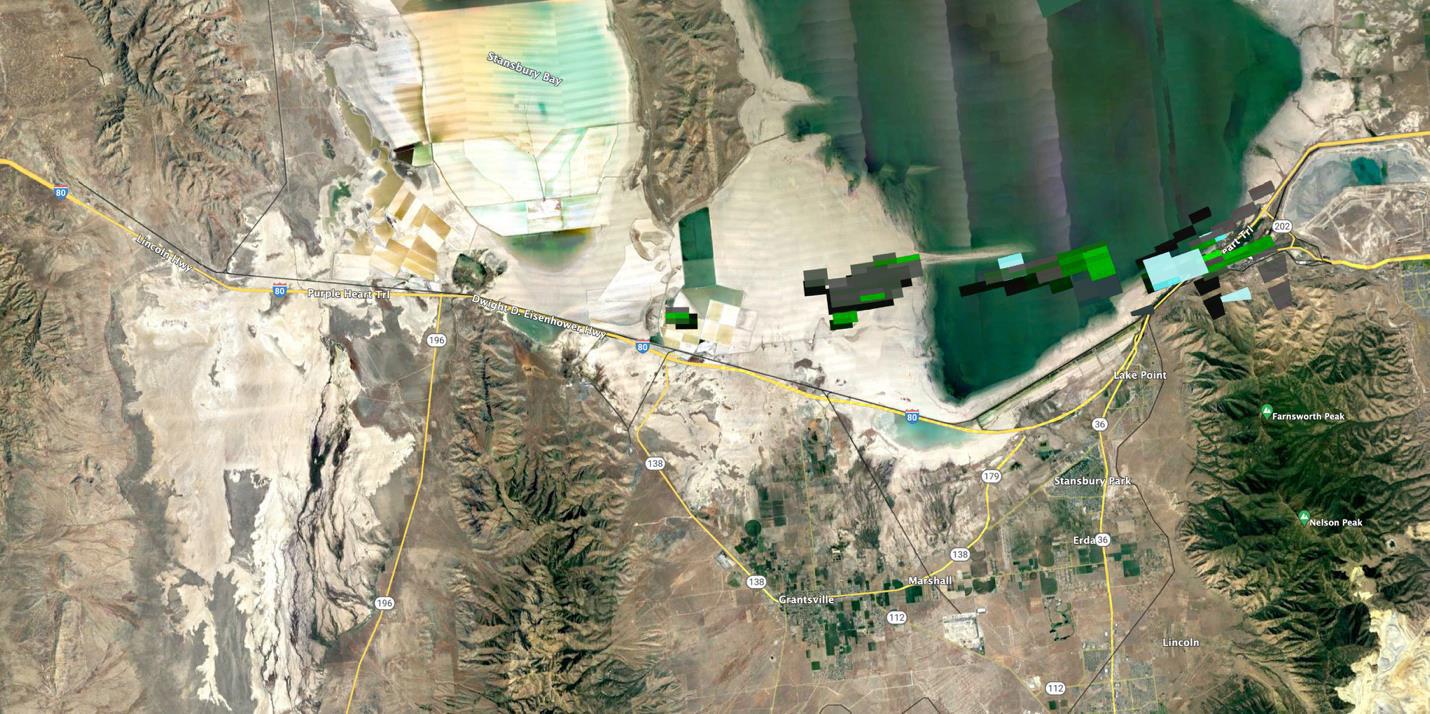
3: Google Earth map of the southern edge of the Great Salt Lake with superimposed Doppler weather radar reflections (black, gray, green and blue polygons) from the meteor(ite) fragments as they fell through the atmosphere. There was little wind on the day of the fall, so meteorites were expected to impact the ground directly below the radar echoes. (Image credit: Marc Fries)

FIGURE
FIGURE 4: BYU geology professor Jani Radebaugh and the author on the hunt for the fallen meteorites on the playa, just west of the southern end of the Great Salt Lake. (Photo credit: Jani Radebaugh)
ground. Conversely, weather radar tracks meteorites falling at very low altitude with high positional accuracy- meteorites are basically found (on the ground) directly “underneath” the radar returns!
Marc got back to me in a day and reported that two Doppler Weather Radars in Salt Lake City and one in Pocatello, ID had recorded signatures consistent with falling meteorites. The first detection occurred at 8:31 AM at 9.5 km altitude above sea level (ASL), and a second detection was recorded at 4.5 km ASL about 30 seconds later. The final radar detection occurred at 8:40 AM, a full nine minutes after the fireball terminus. Marc identified eleven separate radar sweeps with signatures of falling meteorites, with a range of calculated mass estimates (in each sweep) from 0.02 to 3,920 grams. Marc sent along a Google Earth image (Figure 3) with the initial radar echoes superimposed- meteorites had definitely fallen, and they landed near the southern end of the Great Salt Lake, only about 30 miles away from Salt Lake City!
I immediately invited my friend and colleague, Dr. Jani Radebaugh, a fellow planetary scientist and Geology professor at BYU in Provo, to go hunt for the meteorite. She accepted and we made the trip out to the lake on August 16, just three days after the fall. My first impression of the playa (dry lake bed) was that this area was ideal for meteorite hunting! The sandy soil was a light tan color, almost white in the bright sun- it was a perfect background for spotting dark rocks (Figure 4). This is one of the main reasons so many meteorites are found on blue ice in Antarctica- i.e., even cm-sized dark rocks are easy to pick out on a light background, from up to hundreds of meters away. My second impression was that this area was bigger than I realized! We entered the playa from the southern end, and we were on foot; we would have to hike a little over two miles to get to where many of the radar returns predicted the meteorites had landed. We were lucky temperatures were only in the 70’s that morning.
After about an hour of hiking north across the playa I got a text message from Marc: the first meteorite had been found! Sonny Clary, a well-known and accomplished meteorite hunter from Las Vegas, NV had found a piece just west of the lake edge and a bit north of the needle-like peninsula that juts into the

FIGURE 5: The first piece of the fallen meteorite was recovered at about 11:00 AM on August 16, 2022. A black matte fusion crust covers almost all of the meteorite, save for a few brownish orange spots where the crust has chipped away. The brownish orange spots indicate the interior is rusting after just three days exposure to Earth’s atmosphere. Likewise, note the white, salty, evaporite crystals that have formed on the exterior of the meteorite since it landed. (Photo credit: Jani Radebaugh)
lake (see Figure 3). We pressed on, excited to get to the area of the first find to hopefully find more, when we ran into Sonny. He was on a 4-wheeled ATV and decked out in a big, brimmed camo hat and jacket. Strapped to his ATV was a metal detector and a case of bottled water. He looked like he had done this before. A metal detector can help confirm if a rock is a meteorite or not, as about 95% of all meteorites contain iron-nickel metal: iron meteorites are almost wholly composed of this metal, stony meteorites contain varying amounts (<20%) of small metal grains, and stony-iron meteorites are made up of about 50% metal. We didn’t have a metal detector, but we were armed with small household magnets which work just as well. We introduced each other, and Jani and I anxiously inquired if we could see the piece he had just found (Figure 5). It was a beautiful fist-sized rock almost entirely covered with a black matte fusion crust! Fusion crust forms as the outer surface of a meteorite is melted in its descent through the atmosphere. Upon cooling, the melted layer is quickly


FIGURE 6: (above) The first glimpse of the inside of the meteorite revealing dispersed shiny, silvery metal grains and a few light-colored spherical grains in a dark matrix.
(Photo credit: Sonny Clary)
FIGURE 7: (left) Stereo microscope image of the meteorite slice shows silvery, shiny, iron-nickel metal grains adorned by rust halos in a matrix of creamy white- and graycolored silicates. The large, coarsely crystalline, squished-circular grain in the lower left corner is a chondrule.
(Photo credit: James Karner)
quenched to a glassy, eggshell-like crust only a few hundreds of microns thick. The meteorite was also equant shaped and well-rounded on all the cornersalso characteristics due to melting and ablation in the atmosphere, and typical of meteorites. Lastly, the black fusion crust was decorated by white streaks and splotches- some of these were probably the sandy, salty playa soil adhering to the surface, but it was clear others were evaporite crystals that had formed after only three days in Earth’s atmosphere. The rock just looked other worldly; it was definitely a meteorite, and judging from the fresh looking (unweathered) fusion crust, it was most likely from the fireball event!
For the next couple of days, I was in close contact with Sonny- we did a couple of TV news interviews together, chatted about meteorite hunting, and eventually agreed that his meteorite should be classified at the University of Utah, by me, in collaboration with the Cascadia Meteorite Lab at Portland State University. By then, about ten pieces of the meteorite had been found by several different hunters (disappointingly, Jani and were not successful in our hunt), and now there was some urgency to be the first to classify a piece. Classification requires a write up of the fall and find circumstances, including location, pieces, masses, etc. and then determination of what kind of meteorite it is and characteristics it has by petrographic examination. The first classifier also gets to propose a name for the meteorite. The classification write-up is then sent to the nomenclature committee of the Meteoritical Society, an international organization dedicated to research and education on meteorites, for approval. Lastly, as a condition for approval and an official name, a small piece of the meteorite must be donated as a type specimen to a well-curated institutional collection- i.e., a university, museum, lab, etc. This is an effective method to bring privately collected meteorites to science- because in general, a meteorite with an official name is more valuable to meteorite hunters/collectors/enthusiasts as they buy, sell, trade and add to their collections. Additionally, the finder of the type-specimen of a particular meteorite (especially one found after a fireball) garners a bit of cachet among meteorite hunters. Sonny went back to his home lab, cut a piece off the end of the meteorite, and sent it to me. I could
tell immediately that the sample was a stony meteorite- i.e., rocky material along with disseminated silver-colored metal grains (Figure 6). Under the stereo microscope it was clear that the meteorite was a chondrite (Figure 7); so named because they are mainly composed of chondrules- millimeter-sized spheres consisting of silicates (mostly olivine). The chondrules, along with accessory iron-nickel metal and iron-sulfide grains, are all contained in a finer-grained silicate matrix. Chondrites are common, making up about 85% of all meteorite falls, and they are very, very old. In fact, they are basically an agglomeration of the first solid phases that formed in our solar system, ~4.56 By ago! Chondrites quickly accreted to form asteroids, and chondritic parent bodies (asteroids) never melted and differentiated. Thus, chondrites are what we call primitive, or undifferentiated meteorites- and they are the original building blocks of our solar system.
Further petrographic examination revealed the meteorite was dominated by regions lacking clear differences between chondrules and matrix; the bulk of the sample being composed of anhedral olivine and pyroxene grains, with abundant FeNi metal and FeS grains dispersed throughout (Figure 8). A texturally distinct, triangle-shaped clast in the thin section was composed of equigranular 50-100 µm subhedral olivine grains with only very minor FeNi metal grains, and no FeS grains. Electron microscopy (Figure 9) showed that a few sharply defined chondrules and partial chondrules were also present, ranging from ~ 0.25 µm to < 2 mm in size. Also, Fe-Ni metal and FeS grains appeared to have been fluidized; they had scalloped edges where they surrounded silicate grains and were often present as glomerocrysts of the two phases (see Figure 8).
The next step toward classification was to determine the chemical composition of the olivine and pyroxene grains in the meteorite. This would confirm the class (clan) and petrographic grade of the chondrite. While chondrites are derived from parent asteroids that have not been melted and differentiated, they still experience thermal metamorphism and even aqueous alteration while contained in a parent body. The petrographic grade is thus an assessment of the thermal equilibration of the meteorite. A petrographic grade of 3 is pristine; silicates have

FIGURE 8: (left) Cross-polarized mosaic of a whole thin section of the meteorite. The bulk of the sample is composed of several ~mm-sized (semi-)circular chondrules and blotchy areas of agglomerated opaque grains (FeNi metal and FeS). These grains are set in a grayish brown matrix of smaller olivine (bright pink, blue, green) and pyroxene (grey, pale yellow, brown) grains. The triangleshaped “peninsula” in the lower right-hand corner of the image is an igneous clast that shows a granoblastic texture of olivine grains with few opaques. (Image courtesy of Cascadia Meteorite Lab)
FIGURE 9: (below) Backscattered electron image showcasing a Porphyritic Olivine chondrule- i.e., the chondrule is composed of phenocrysts of blocky olivine set in a finegrained feldspathic matrix. Ol = olivine, Pyx = pyroxene, FeNi = iron-nickel metal, and FeS = iron sulfide.




heterogeneous compositions and still retain chemical zoning, while chondrules have sharp boundaries in the matrix. Petrographic grades of 4, 5, and 6 show increasing compositional homogeneity of silicates and decreasing delineation between chondrules and matrix. Electron microprobe analysis showed that olivine grains had an average Fayalite (Fa) content of 19.6 mol.%, while low-Ca pyroxene grains had a Ferrosilite (Fs) content of 17.0 mol%, and there was little deviation in those silicate compositions throughout the sample (s.d.= ~0.3 mol%). Thus, the chemical composition and petrography revealed the meteorite was an H5 chondrite. The H means the chondrite has a relatively high modal percentage of FeNi metal grains (and a high ratio of metallic iron/oxidized iron), while a petrographic grade of 5 denotes the chondrite is well-equilibrated.
The last task towards classification was to propose a name for the meteorite. Guidance provided by the Meteoritical Society states, “A new meteorite shall be named after a geophraphical locality near to the location of its initial recovery.” Easy, I thought- it had to be “Salt Lake City.” The fireball had pretty much exploded directly over the city, tens of thousands of metro residents had heard that cosmic explosion, and the first pieces of the meteorite were recovered just a few miles from the city proper. It would have been an apt name, but it was already taken- a meteorite named Salt Lake City had been found in 1869. I thought a bit more and settled on a name that I now think is better, cooler maybe... In December of 2022, the Meteoritical Society approved the classification, and the new meteorite was officially named Great Salt Lake (Karner et al. 2023)! Great Salt Lake is the 27th meteorite from Utah and one of only two meteorites ever recovered after a fall in the Beehive State. Additionally, and perhaps the most exciting part about the Great Salt Lake
fall (scientifically), is that the pre-impact orbit of the meteorite has been determined from video and photographic recordings (Jenniskens and Devillepoix, 2025). This essentially means we have traced the elliptical orbital path of Great Salt Lake from its origin in the asteroid belt, between Mars and Jupiter, through its final lap around the Sun and collision with Earth! Furthermore, the combination of the recovery and classification of the meteorite, along with the determination of its pre-impact orbit, is a relatively rare scientific achievement: these data are currently helping planetary scientists match specific meteorite types to their specific parent bodies (asteroids and asteroid families) in our solar system!
In conclusion, the Great Salt Lake meteorite fall was an amazing celestial event witnessed by thousands of humans. Scientifically, the study of both the fall and the meteorite will provide valuable contributions to cutting-edge planetary science. Personally, the experience of hearing the explosion of the fireball, and then taking part in the recovery, classification and naming of the meteorite was somewhat of a dream-come-true for a planetary scientist- I’ll always feel lucky to have been a part of the event! I just wish I had found the first piece.
REFERENCES
Karner, J.M., M.D. Fries, M.L. Hutson, A.M. Ruzicka, D. Sheikh, and M. Terlaga, (2023), The fall and recovery of the Great Salt Lake meteorite. 85th Annual Meeting of the Meteoritical Society, Abstract #6307.
Norton, R.O., (1998), Rocks from Space. Mountain Press Publishing Co. Cressey, F. (2016), From Weston to Creston: A compendium of witnessed US meteorite Falls 1807 to 2016. Frank Cressey. American Meteor Society (2022, August), Fireball event 49422022. https://fireball.amsmeteors.org/members/imo_view/ event/2022/4942
Fries, M.D. and J. Fries (2010) Doppler weather radar as a meteorite recovery tool. Meteoritics & Planetary Science 45, Nr 9, 1476–1487, doi: 10.1111/j.1945-5100.2010.01115.x
Jenniskens, P. and Devillepoix, H. (2025) Review of asteroid, meteor, and meteorite-type links. Meteoritics and Planetary Science 60, Nr 4, 928-973, doi:10.111/maps.14321
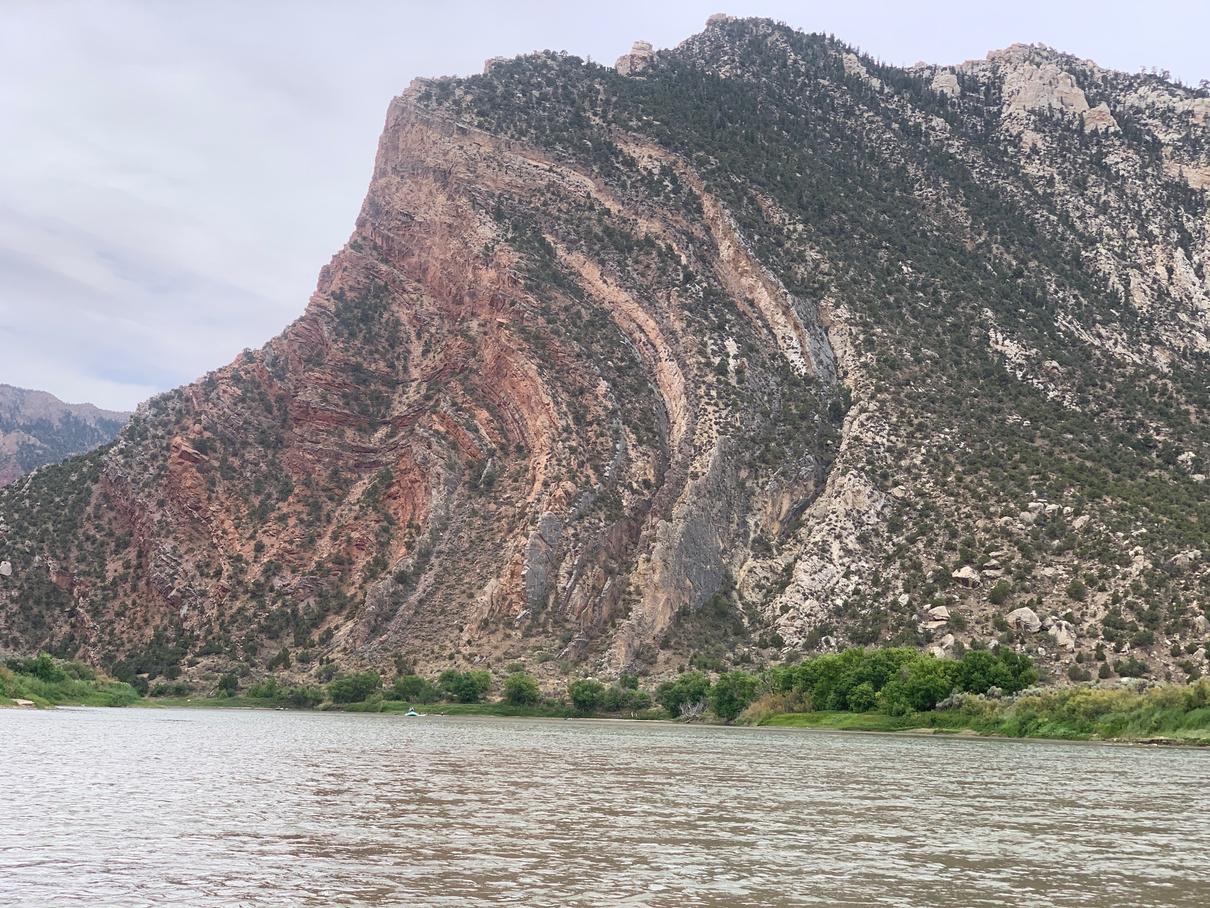

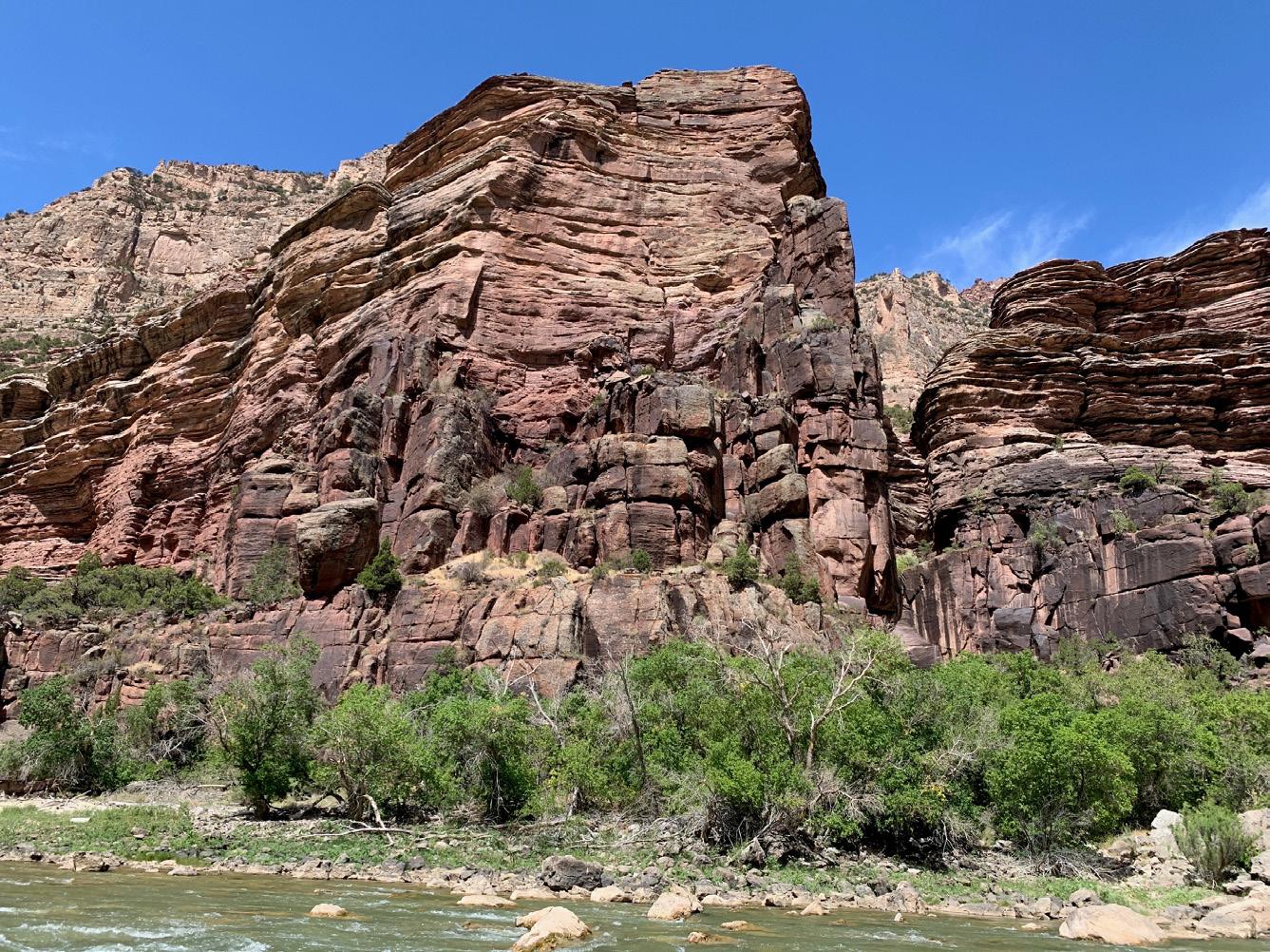

YAMPA RIVER AND GREEN RIVER FLOAT TRIP
JUNE 1-5, 2026
Join RMAG for a five-day float trip on the Yampa and Green Rivers! Guided by Dr. Gary Gianniny, this unforgettable geologic adventure will explore the breathtaking stratigraphy and structures of Dinosaur National Monument including towering Paleozoic canyons to iconic features like the Mitten Park Fault and Split Mountain Anticline.
Speaker: John McLeod
Date: November 4, 2025 | 12:00 pm - 1:00 pm
Revisiting the Geologic Resources of Ukraine

Presenter: John McLeod
The 2025 “minerals deal” between the U.S. and Ukraine rekindled interest in a subject I first presented online in 2022 in the earliest days of the Russian invasion. Ukraine is a country blessed with a diversity of geology and geologic resources. Its major geologic provinces include the Caucasus fold belt, the Lviv-Volyn basin, Ukrainian Sheild
and its flanks, the Dnieper-Donets basin, the Donbas fold belt, and the Black Sea coastal plain and offshore shelf. Before the war, it was a major producer of iron ore and titanium, with a complementary steel industry in Mariupol (since destroyed). It had a sizable anthracite coal industry in Donbas, oil and gas production in the Caucuses, Lviv-Volyn,
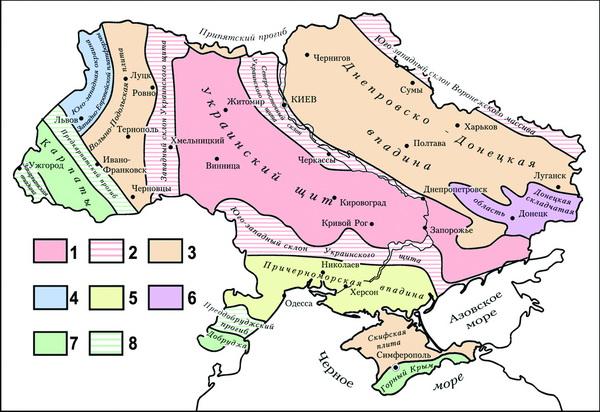
SOURCE: MINERAL RESOURCES OF UKRAINE
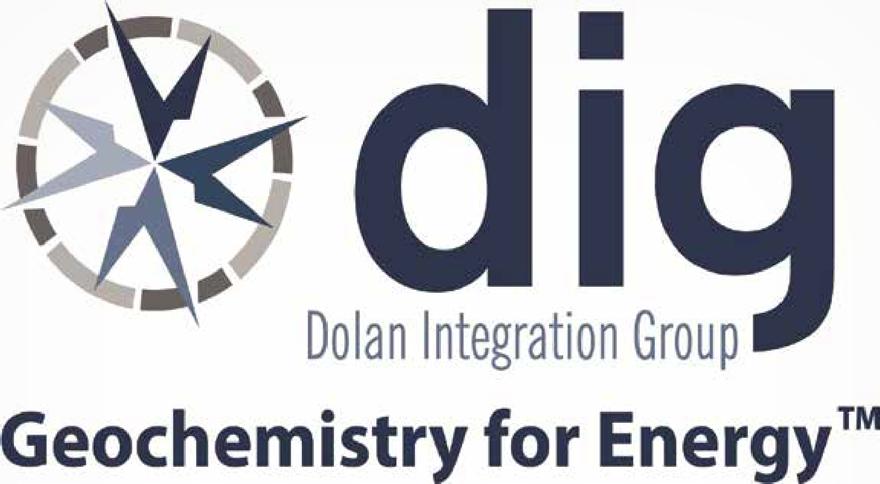




























































Dnieper-Donets and coastal plain (onshore and offshore), and served as an import conduit for Russian gas transported to Turkey and Western Europe. It produced other minerals like uranium, which served as feedstock for its significant domestic nuclear power industry. In exports, Ukraine is an agricultural “breadbasket” due to the

presence of thick Quaternary chernozem soils. Over time, the interest in a deal for Ukraine geologic resources has shifted from rare earth elements to strategic minerals to just “minerals.” The terms are perhaps deliberately vague (or flexible) and have yet to be implemented because of the ongoing conflict.
John McLeod is a geologist whose primary interests are new ventures exploration, petroleum systems analysis, geochemistry and paleontology. He held geologist positions with Mobil Oil, Oryx Energy, EOG Resources, Chesapeake Energy and SM Energy. Since late 2019, he has been an independent geoscientist involved in teaching (QGIS open source mapping), geological research (Ukraine, Oklahoma, Illinois), field geology and geochemistry. He co-lead the RMAG Eagle Basin field trip last year and is an occasional online contributor to LinkedIn. John holds an M.S. in Geology from Northern Illinois University.



CALL FOR PAPERS
PETROLEUM HISTORY INSTITUTE 2026 ANNUAL SYMPOSIUM AND FIELD TRIP
BAKERSFIELD, CALIFORNIA


The World of West Coast Petroleum April 16-18, 2026
REGISTRATION AND EVENING RECEPTION Thursday, April 16, 2026
PRESENTATIONS-ORAL AND POSTER – Friday, April 17, 2026 Proceedings to be published in the 2026 Volume of Oil-Industry History
FIELD TRIP – Saturday, April 18, 2026
HEADQUARTERS HOTEL – Double Tree by Hilton, Bakersfield, California RLBK_DT_Hotel@hilton.com, or (661)-323-7111 or (661) 632-2202 For group Rate mention “Petroleum History Institute”
REGISTRATION DETAILS TO FOLLOW
ABSTRACTS BEING ACCEPTED Deadline: March 1, 2026
Please send abstracts to: Dr. William Brice - wbrice@pitt.edu or call Co-chair Vaughn Thompson – (805) 794-0070; geologistvaughn@gmail.com
HYBRID
Speaker: Dr. David Krause
Date: December 3, 2025 | 12:00 pm - 1:00 pm

The Madagascar Paleontology Project: Late Cretaceous Game-Changers
Presenter: Dr. David Krause, Denver Museum of Nature and Science
Madagascar is one of the very poorest countries in the world but is rich in fossils, including some of the world’s most spectacular and significant: snaggletoothed and dome-headed dinosaurs, vegetarian pugnosed crocodiles, basketball-sized armored frogs, and mammals with swiss-cheese skulls. I will highlight some of these fantastic discoveries from the
Late Cretaceous of Madagascar made over the course of the last 33 years and put them into context of the plate tectonic and biogeographic history of Madagascar, but also of Gondwana as a whole. Given the audience, I will also emphasize various aspects of the stratigraphy, sedimentology, and taphonomy of our field areas.
DR. DAVID KRAUSE is Senior Curator of Vertebrate Paleontology at the Denver Museum of Nature & Science; Emeritus Distinguished Service Professor at Stony Brook University; Founder and Executive Director of the Madagascar Ankizy Fund; former Editor of the Journal of Vertebrate Paleontology; and former President of the Society of Vertebrate Paleontology. Born and raised on a remote cattle ranch in Alberta, Canada, Dr. Krause received his B.Sc. and M.Sc. from the University of Alberta and his Ph.D. from the University of Michigan. He was awarded a Distinguished Alumni Award from the University of Alberta in 2010, an honorary doctorate from The University of Antananarivo (Madagascar) in 2012, and the Romer-Simpson Medal from the Society of Vertebrate Paleontology in 2023 (the society’s highest award). Dr. Krause is a 50-year veteran of field research in Canada, the United States, Pakistan, India, and Madagascar and has published over 135 peer-reviewed research articles and edited four monographic volumes.
D eta ile d a nd ac c ura te g eo lo gy at yo u r fin g ertip s in Pe tra , Ge o Grap h ix, A rc GIS , A cc u Map , ge o S C OU T an d o th er d ig ital ma p pin g a p plica tion s
We ste rn USA
Geol ogi cal Edge Set
Ene rgy Al te rnati ve s & Cri ti cal Mine ral s - USA
We ste rn Cana da Geol ogi cal Edge Set
Ene rgy Al te rnati ve s & Cri ti cal Mine ral s - Ca nada
Ea ste rn USA & Ea st ern Ca nada
Geol ogi cal Edge Set
Cent ral USA
Geol ogi cal Edge Set
Me xi co
Geol ogi cal Edge Set
Map la ye rs p rov ided in s ha pe file fo rma t fo r ea sy impor t into a ll ma ppin g app lic at ions .
De liv er ab le s inc lude : f orma tion limits , o utc ro ps, su bc rop e dge s , O &G fie ld s, st ruc tu ra l eleme nt s, re ef s, sh ore lin es , c ha nne ls, pro duc tion f airw a ys , s ha le ga s tr en ds, st ru ct ure con tou rs , iso pa chs , g en era l cult ure , r ene w able & no n-r en ew ab le ene rg y pr ojec ts , min era l dep os it s, mine s, Pet ra T he mat ic Ma p pro je ct s, G eoG ra phix G e oA tla s pro je c ts , Ar cG IS M XD a nd La y er f ile s, re giona l c ro ss -s ec tion s, an d full te ch nica l s upp ort .
For mo re inf orma tio n: Joe l H a rding at + 1 4 03 87 0 8 12 2 joe lha rding@ g eoe dg es .c om ww w.ge oe dge s.c om
GEOLOGICAL FIELD TRIP, OURAY, COLORADO
OCTOBER 19-21, 2025
By Callum Thurley, Kimmeridge Energy
Reviewed and edited by Rob Diedrich and trip leaders, David Gonzales and Steve Cumella


From October 19–21, 2025, RMAG convened in Ouray, Colorado, to learn about the stratigraphy, structure, magmatic history, and economic mineralization of the western San Juan Mountains. The field trip provided an opportunity to integrate observations across multiple formations and intrusive events, with discussions focused on tectonostratigraphic evolution, magmatism, and implications for the tectonic evolution of the Ouray area and broader Rocky Mountains.
DAY 1 - 20TH SEPTEMBER
We began with an overview of the local stratigraphy and structural framework before moving to a valley overlook at the Amphitheatre campground. Here, the complete section was visible: the 1.7 Ga Uncompahgre Formation at the base; the Leadville Limestone, notable for replacement-style mineralization (Ag, Pb, Cn, Cu-Au) associated with primary and secondary porosity infill; the Pennsylvanian Hermosa Group with minor interbedded limestones; and the overlying Cutler Formation (Pennsylvanian–Permian muddy sandstones) - Figures 1 and 1a. Regional discussions led to the mentioning of these formations being
equivalent to the Paradox Formation evaporites and organic rich shales in the nearby Paradox Basin. Portions of the Mesozoic succession remain in place on the western side of the valley, though much has been removed by erosion across the rest of the Ouray area. The entire section is overlain by a blanket of volcanic rocks that make up the Oligocene San Juan Formation. Igneous intrusions cut throughout the stratigraphy (with the younger intrusions being more felsic in nature), and local geothermal activity is fault-controlled, including along the famous Ouray Fault.
At the Baby Baths Trail,after a short hike we examined collapse breccias within the limestone beds of the Leadville Limestone, interpreted as cavern collapse features with (potentially!) evidence for subsurface fluid flow.
Lunch at Rotary Park highlighted alluvial sedimentary structures within the Cutler Formation, including cross-bedded sandstones, erosional channels with conglomeratic fill (Figure 2). Also, a breccia dike of igneous origin could be observed in a large boulder of the Cutler Formation. The breccia dike is believed to be the result of explosive magmatic degassing as the intrusion rises to the surface and rips clasts from the overlying
RMAG ON THE ROCKS: OURAY, COLORADO

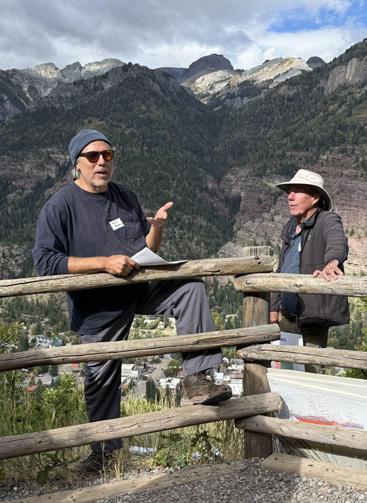
the regional geology at the Amphitheatre Campground Overlook.
FIGURE 1: (above) Overview of Ouray Valley from the Amphitheatre Campground.
FIGURE 2: (below) Cutler Formation sandstones with sedimentary structures at Rotary Park.

FIGURE 1A: Our leaders, David Gonzalez (left) and Steve Cumella (right) explaining
RMAG ON THE ROCKS: OURAY, COLORADO
formations and incorporates them into a melange of apparently clastic material. Interestingly, when assessing these regionally, this phenomenon appears to occur at a consistent depth of around 2,500ft below the earth’s surface indicating a pressure control on magmatic degassing. Across the road, a monocline with gentle folding was visible and traceable across the valley, its origin debated as being either extensional or reverse fault related.
The Amphitheatre viewpoint offered a spectacular view of a paleovalley with over 1,000 ft of relief, at the base of the Cenozoic revealing a striking unconformity between Paleozoic/ Mesozoic strata and the San Juan Volcanics (Figure 3). Today, this is the representation of a vast paleo-valley cut into Paleozoic strata subsequently infilled by rocks of the San Juan Formation. Clear evidence for the Cutler Formation thinning towards the amphitheatre indicates syndepositional uplift, with incision producing a 1500–2000 ft paleo-valley. Clast provenance in Cutler conglomerates revealed Precambrian volcanics, with upward younging trends recording progressive unroofing of volcanic successions. Precambrian zircons are ubiquitous in the 75-25 Ma intrusive rocks in the area, strongly suggesting melting of Proterozoic lithosphere during magma production. After 25 Ma, mantle-derived mafic magmas were emplaced in the region, which was accompanied by the production of small volumes of high-silica felsic intrusive rocks.. Structural discussions emphasized that mountain building in the region is likely tied more to Neogene, Rio Grande Rifting, and Colorado Plateau rotation than to

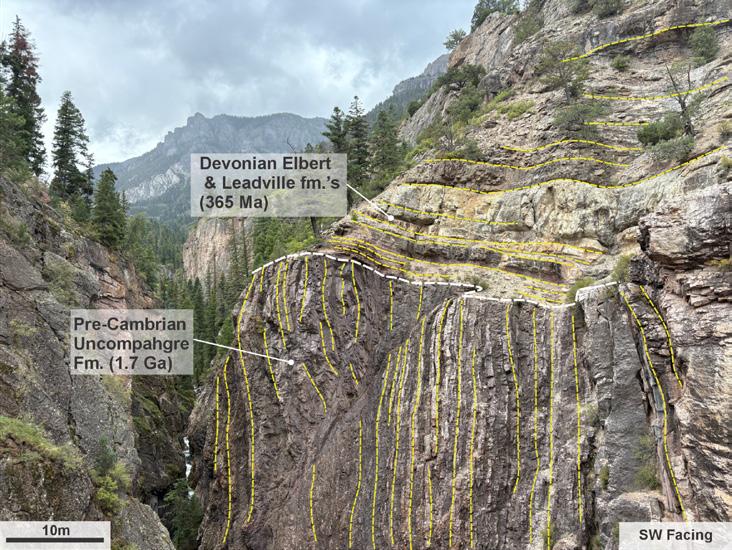
Laramide compression.
The day concluded at the “Great Unconformity,” where vertically dipping Paleoproterozoic quartzites abut Leadville/Elbert limestones at a striking angular unconformity, marking ~1.45 Ga of missing time. A ~1.4 Ga gabbroic sill (formerly described as a dike!), is truncated beneath the unconformity,
FIGURE 3: (above) View of the Amphitheatre showing the complexity and interaction of sedimentology, structural geology, and present day geo-morphology.
FIGURE 4: (below) The Great Unconformity at Box Canyon
providing age control on the quartzite-phyllite sequence (Figure 4)
DAY 2 - 21ST SEPTEMBER
Traveling the Million Dollar Highway, we examined sedimentary features in the Uncompahgre Formation, including marine mega ripples (Figure 5) Here, the San Juan Formation rests unconformably on the Uncompahgre, with ~1.7 Ga of geologic time absent. A preserved recumbent fold in the Uncompahgre underscored the importance of mechanical stratigraphy and rheology in deformation zones (Figure 6).
At Angel Creek, three features were particularly instructive: (1) a second breccia dike within the Hermosa (Figures 7 and 7a), (2) an igneous intrusion exploiting bedding-plane weaknesses, causing localized deformation, with its termination visible, and (3) well-preserved sedimentary structures including cross-bedding, load casts, flame structures, and soft-sediment deformation (Figure 8)
The final stop of the trip was at an abandoned carbonate-hosted mine, allowing examination and collection of minerals within the limestone units of the Jurassic Pony Express Limestone that include malachite, azurite, galena, and barite (Figure 9).


6: Recumbent fold in the metapelites of the Paleoproterozoic Uncompahgre Formation.
FIGURE 5: Mega ripples exposed in the 1.7Ga Uncompahgre Formation
FIGURE

FIGURE 7: (above) Polymictic rock texture of the breccia dike
FIGURE 7A: (below) Our group gathers around the breccia dike at Angel Creek

FIGURE 6: Recumbent fold in the metapelites of the Paleoproterozoic Uncompahgre Formation.


FIGURE 8: Soft Sediment deformation and cross bedding shown in the Hermosa Formation at Angel Creek.
Beautiful examples of algal/stromatolite replacement mineralization were abundant as well as an old abandoned 1941-6 Chevrolet AK! (Figure 10).
From here, looking north down the Ouray valley, discussions broadened to the Ridgway fault system (Figure 11), its relevance and relationship to the ancestral Rockies. Most importantly, the absence of the Paleozoic section on the upthrown (north) side of the fault demonstrates that this fault bounded the Ancestral Uncompahgre uplift. This reflects the importance in understanding tectono-stratigraphic history when attempting to understand complex inter-montane Rocky Mountain basins.
RELEVANCE TO BASIN SCALE PETROLEUM EXPLORATION IN THE ROCKIES
• The field trip emphasized the significance of magmatic history for heat flow, source rock maturity, and regional petroleum prospectivity.
• Tectonostratigraphic variability at small spatial scales reinforces the need for detailed basin analysis.
• While Laramide compressional structures remain imprinted across the Rockies, Neogene uplift related to mantle upwelling and related block uplift appears to dominate modern topography in the southern Rocky Mountains.
• Importantly, Neogene exhumation of source-rocks such as the Mancos Shale contributes to the latestage charging of tight-gas-sand reservoirs — a critical exploration component in all the Rocky Mountain basins today.
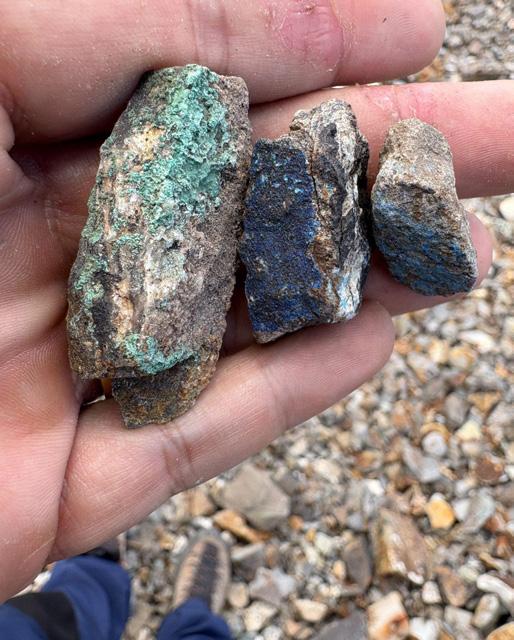

FIGURE 9: Copper minerals (malachite & azurite) recovered from the waste material from the mine.
FIGURE 10: Derelict Chevrolet AK (1941-6) at old mine
RMAG ON THE ROCKS: OURAY, COLORADO
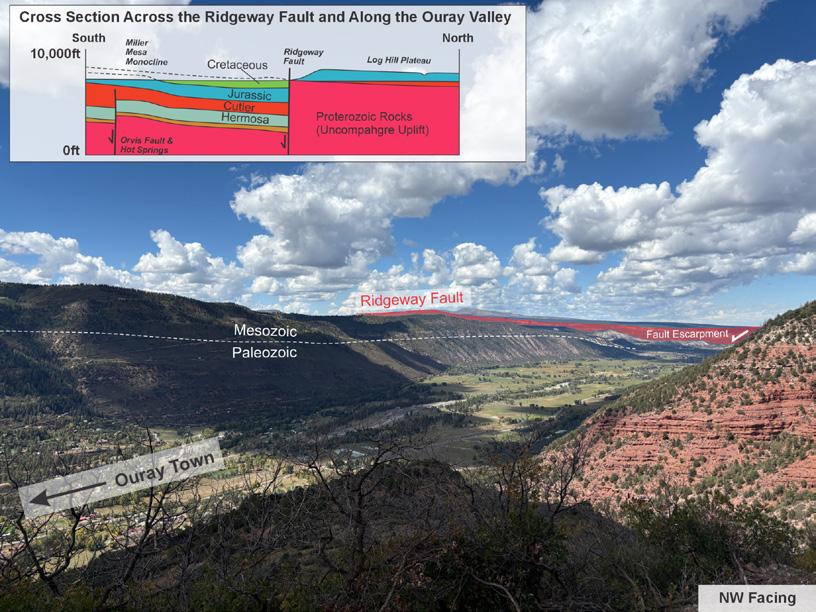
FIGURE 11:
Overview looking north out of Ouray valley towards the Ridgeway Fault, Cross Section modified from Ewing (2017).


Why contribute?
Expanded geologic focus:
Why contribute?
• Reach
• Quarterly
• Permanent
geologic focus: Entire greater Rocky Mountain West Texas and New Mexico -Continent
Expanded geologic focus:
• Quick
• Every
• Entire greater Rocky Mountain area of North America
• West Texas and New Mexico to northern British Columbia
• Entire greater Rocky Mountain area of North America
• Reach a broad industry and academic audience
• Great Plains and Mid-Continent region
• West Texas and New Mexico to northern British Columbia
• Quarterly peer reviewed journal
• Great Plains and Mid-Continent region Why contribute?
• Permanent archiving includes AAPG Datapages
• Reach a broad industry and academic audience
• Quarterly peer-reviewed journal
• Quick turn around time
• Every subdiscipline in the geosciences
• Quick turn-around time
https://www.rmag.org/publications/the
• Permanent archiving includes AAPG Datapages
https://www.rmag.org/publications/the
• Every subdiscipline in the geosciences
Expanded geologic focus:
area of North America
• Entire greater Rocky Mountain area of North America
northern British Columbia region
• West Texas and New Mexico to northern British Columbia
• Great Plains and Mid Continent region

Email: mgeditor@rmag.org
https://www.rmag.org/publications/the -mountain-geologist/

IN THE PIPELINE
NOVEMBER 4, 2025
RMAG Luncheon.
Speaker: John McLeod. “Revisiting the Geologic Resources of Ukraine.” 12:00-1:00 PM. DERL, 730 17th Street, B1, Denver.
NOVEMBER 5, 2025
WOGA Tech Lunch.
Speaker Michelle Ehlers-Peterson. “Why CryoHistory and Drivers for What, When and How of Cryogenic Gas Processing.” CANUSA, 600 17th Street, #1400n, Denver. 11:00 AM-12:30 PM.
NOVEMBER 6, 2025
Colorado School of Mines. Distinguished Alumni Award.
Honoring Donna Anderson. Inspiring Talks and a Reception.
NOVEMBER 12, 2025
DPC Fireside Chat.
Speakers: Osman Apaydin and Roger Biemens. Happy Hour and Networking starts at 4:30 PM,
Cal Ruleman with the US Geological Survey from Evergreen, Colorado
Robbie Horner with CH4 Energy Six, LLX/Unita Wax from Fort Worth, Texas
Natalie Kongable from Center Point, Iowa
Program begins at 5:00 PM. Appetizers and beverages provided. Liberty Energy, 950 17th, St #24, Denver. Register at denverpetroleumclub. com.
NOVEMBER 13, 2025
WOGA Wellhead Wake-Up (Virtual Monthly Coffee Chat) Virtual. 8 AM.
NOVEMBER 18, 2025
RMAG Happy Hour. 4 PM. Living the Dream Brewing, 9150 Commerce Center Circle, Ste. 300, Highlands Ranch, CO.
NOVEMBER 20, 2025
RMAG Coffee Hour. Vibe Coffee & Wine, 1490 Curtis Street, Denver.
WOGA Lean- In.
Speaker: Camille Romero. “Taking Yourself to Market-Making Your Voice Heard.” CANUSA, 600 17th Street, #1400n, Denver. 11:00 AM-12:30 PM.
Mitchell Sigler from Englewood, Colorado
Sue Pritchett with Lumina Geophysical from Houston, Texas
Conor Sullivan with Geosyentec Consultants from Lakewood, Colorado
Kurt Anderson from Comanche Pines Enterprises, LLC from Franktown, Colorado
Blake Waldo from Oklahoma
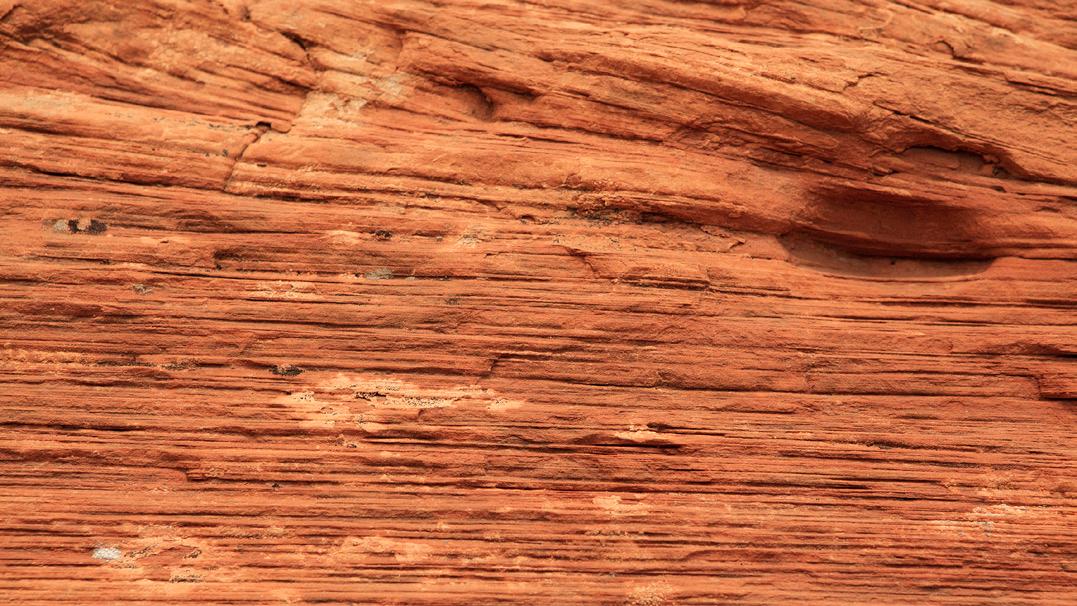

RMAG Happy Hour.
WOGA Tech Lunch.
DPC Fireside Chat.
Colorado School of Mines. Distinguished Alumni Award.
WOGA Wellhead Wake-Up
RMAG Coffee Hour.
WOGA Lean- In.
